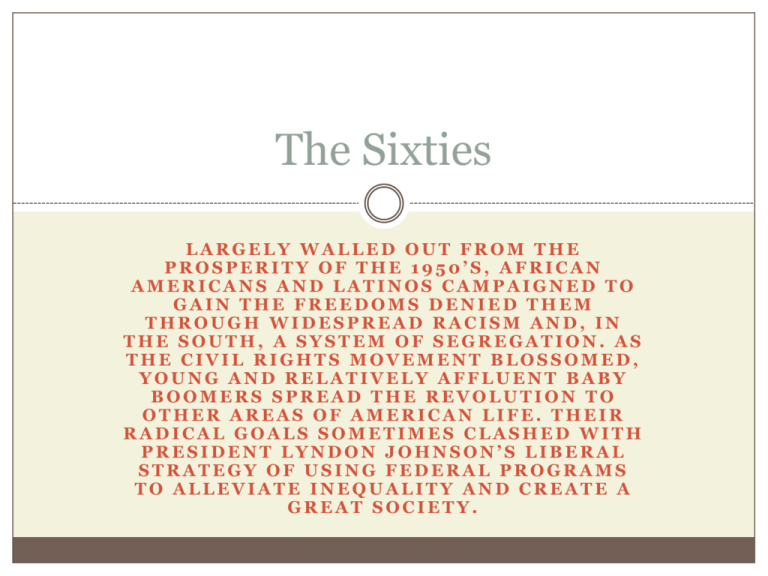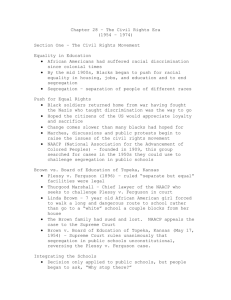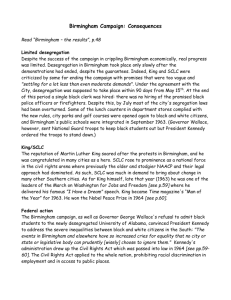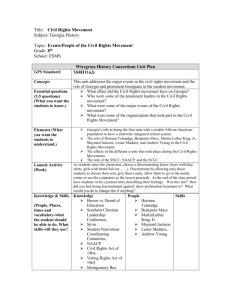greatsociety
advertisement

The Sixties LARGELY WALLED OUT FROM THE PROSPERITY OF THE 1950’S, AFRICAN AMERICANS AND LATINOS CAMPAIGNED TO GAIN THE FREEDOMS DENIED THEM THROUGH WIDESPREAD RACISM AND, IN THE SOUTH, A SYSTEM OF SEGREGATION. AS THE CIVIL RIGHTS MOVEMENT BLOSSOMED, YOUNG AND RELATIVELY AFFLUENT BABY BOOMERS SPREAD THE REVOLUTION TO OTHER AREAS OF AMERICAN LIFE. THEIR RADICAL GOALS SOMETIMES CLASHED WITH PRESIDENT LYNDON JOHNSON’S LIBERAL STRATEGY OF USING FEDERAL PROGRAMS TO ALLEVIATE INEQUALITY AND CREATE A GREAT SOCIETY. The Freedom Movement THE PERIOD OF 1954-1965 MARKED A MAJOR SHIFT IN THE CIVIL RIGHTS STRATEGY OF AFRICAN AMERICANS. THE RULING IN BROWN HAD EMBOLDENED LARGE PARTS OF THE COMMUNITY TO DEMAND CHANGE NOW. THE AGE OF GRADUALISM AND DEFERENCE HAD ENDED. THE AGE OF DIRECTED COMMUNITY ACTION HAD BEGUN. Mendez v Westminster Mexican American children segregated in public schools Segregation not based on race Everyone agreed Mexicans were white The district claimed that children were segregated because they were Spanish-speaking Supposedly, they could enter white school when they demonstrated English proficiency That never happened The parents and community took the district to federal court Court found that the district violated Mexican Americans right to equal access and due process Court demanded schools be segregated Ultimately, the federal 9th circuit court upheld the district courts ruling The state of California, led by governor Earl Warren, forced integration Brown v Board of Education of Topeka NAACP had a long-term legal strategy: chip away at the Plessy ruling Thurgood Marshall led the NAACP legal team Marshall had reviewed Mendez and used it as a model Peter Clark who had worked on a companion case Briggs joined Brown was five similar cases heard together In Briggs the plaintiffs had utilized social scientist testimony Clark, Holt, and Speer all testified that segregation brings on a sense of inferiority that damaged the ability of African American children to adapt and succeed Chief Justice Earl Warren The court had determined the time had come to end segregation Warren coerced hold outs to join the majority for a unanimous decision 9-0 deciscion reached Court ruled that education was too important success and needed to be provided at equal quality for blacks and whites Separate can never be equal—essentially ended Plessy Rosa Parks December 1, 1955 43-yearl old department store seamstress and civil rights activist Refused to give up her seat to white man She had not planned to protest that day She had planned to resist at the next opportunity Trained for the challenge for years When she saw her opportunity she acted Plans of the Women’s Political Council and NAACP came into play Bail Parks out of jail Began mobilizing black community leadership behind her WPC sent out a flyer calling for a one-day boycott of the buses 30,000 printed WPC had planned distribution routes month earlier In one day hundreds of volunteers distributed them across the city Montgomery Improvement Association (MIA) Formed by NAACP, WPC, and MVL Chose 26-year old minister Martin Luther King, Jr. as its president On December 5, he called the community to unify behind the boycott Martin Luther King, Jr. Earned PhD in Theology at 25 from Boston University Move with wife Coetta to become pastor of Dexter Avenue Baptist Church Combined Gandhian nonviolence with black Christian faith and church culture “we must realize so many people are taught to hate us that they are not totally responsible for their hate” Their hate manifest it self in bombs lobbed at the homes of King, Nixon and MIA leaders, Ralph Abernathy and Fred Shuttlesworth Boycott in Action Walking for freedom Men led but women were key to its effectiveness For 381 days black women dependent on buses refused to ride Boycott took 65% of bus company business Organized car pools Walked miles to work Were supported by white employers Organized bake sales and other forms of fund raising $2,000 per week was raised to keep carpools going Company might have relented but it was under a city charter Officials refused concessions, like “first come, first served” As the boycott drug on NAACP opened a legal path to victory Victory By 1956, many began to lose hope November 13, 1956, Gayle v Browder Case had been brought by NAACP in support of Colvin, Parks and other arrested Unlike Brown, Gayle expressly overturned Plessy On the same day the state had secured a court injunction to end the MIA car pool Bus company ended segregation and hired African American drivers Little Rock, Arkansas September 1957, governor Faubus posted 270 national guardsmen around Central High to prevent 9 black students from entering After court forced Faubus to allow students in he removed troops and left the children alone to face a mob Eisenhower sent in the 101st Airborne and put the state national guard under federal control First time since Reconstruction federal troops used in South Sit-ins: the kids take over February 1, 1960, Greensboro, NC Joseph McNeil, Francis McCain, Ezell Blair, Jr., and David Richmond all freshman at North Carolina Agricultural and Technical College sit at the lunch counter of Woolworth’s five-and-dime Well planned out: all four had been members of the NAACP They had shopped in the store and placed their receipts in front of them and waited to be served They were ignored as they sat doing their homework When the store closed they left February 2, word had spread of the sit-in and other students joined Within 5 days hundreds of well dress students crowded the store Soon it spread to other white stores Nashville, Atlanta, joined in similar boycotts By April more than 2,000 students in 78 southern cities were arrested By the summer, 30 cities had set up community organizations to address the complaints of local blacks Freedom Rides The Congress for Racial Equality’s (CORE) Bayard Rustin and James Farmer called for a test of interstate transportation segregation Inspired by Rustin’s 1947 “Journey of Reconciliation” Reached Chapel Hill, NC where they were met by a mob and arrested Sentenced to 30 days on a road gang May 4, 1961, a group of interracial riders set out on a bus trip from D.C. to New Orleans 13 riders, seven black, 6 white In Rock Hill, SC John Lewis one of the black riders entered the white waiting room at the Greyhound terminal Brutally beaten by white mob as police looked on Violence made escape from Alabama difficult At Anniston, AL a mob firebombed the bus and beat escaping riders Local African-Americans led by Reverend Fred Shuttlesworth took the riders to Birmingham The ride continued on to Alabama heading to MS Without police protection CORE abandoned the Freedom Rides SNCC refused to let the Freedom Rides dies 20 civil rights workers went to Birmingham to meet the riders May 20, rode to Montgomery An angry mob of more than a 1,000 met them No police Everyone on bus had to be hospitalized, including a presidential aide sent to monitor the crisis Attorney General Robert Kennedy had enough May 21, sent 400 federal marshals to restore law and order The first protected was a meeting of 1,200 men, women and children meeting at Ralph Abernathy’s church King spoke and called the crowd to resolve Outside federal troops had surrounded the building but were outnumbered Governor John Patterson ordered National Guard and state troopers to protect protesters and aid the Marshals The Election of 1960 The election was the culmination of southern fears Blacks had the vote and could be the deciding factor John F. Kennedy As a Democrat, had done little to distinguish himself as a friend of African Americans Richard Nixon Was supported by Jackie Robinson and many black leaders Remained silent on civil rights The Republican Party had a strong pro-civil rights record King sentenced to four months in prison for leading nonviolent protest in Atlanta Kennedy called Coretta Scott King to offer support Robert F. Kennedy used his influence to obtain King’s release The Kennedys actions impressed and won over black voters This was the difference In Illinois black voters cast 250k votes for Kennedy who won the state by 9,000 The Kennedy Administration and the Civil Rights Movement Kennedy found himself restrained by the white Southern of his party and in Congress Executive Order #11063 Required government agencies to discontinue discriminatory policies and practices in federally supported housing Named Vice-President Lyndon Johnson to chair the newly formed Committee on Equal Employment Opportunity Nominated Thurgood Marshal to the Second Circuit Court of Appeals More than 40 African Americans were given positions in the administration Robert Kennedy brought force to the Civil Rights Division Brought in noted attorneys to litigate for the agency Voter Registration Projects June 16, 1961 Robert Kennedy met with student leaders Urged them to redirect efforts to voter registration and reduce direct-action activities Persuaded students that greater access to voting would result in profound and significant social change By October 1961, SNCC, NAACP, SCLC and CORE joined together in a voter education project The groups took different regions of the south Attempts to register voters unleashed a wave of violence and murder across Mississippi The Birmingham Confrontation By early 1963 the movement had stalled SCLC, in Birmingham, launched a massive campaign marking the 100th anniversary of the Emancipation Proclamation Despite strong organized community committees few gains had been made Without federal support, the movement had little leverage The city was tightly segregated Blacks were victims of severe police brutality, as well as economic, educational, and social discrimination The KKK operated without limits Project C A coalition of protest groups called the Alabama Christian Movement for Human Rights, led by Reverend Fred Shuttlesworth, joined with the SCLC Prepared massive pickets, boycotts, and demonstrations Demanded integration of public facilities, guarantees of employment opportunities for black workers in downtown businesses, desegregation of schools, improvement of services in black neighborhoods, and low-income housing Hoped to provoke the city’s safety commissioner Eugene T. “Bull” Connor, who had a reputation for visciousness • Civil rights leaders believed Connor’s conduct would horrify the nation and compel Kennedy to act. April 3 the project began with college students conducting sit-ins April 10, marches began Connor seemed to have learned from Pritchett Arrests but no violence April 12, state court prohibited further protests King and Abernathy violated the ruling and were arrested While in jail, eight local Christian and Jewish leaders signaled their objections to his “unwise and untimely” protest King had smuggled a pen into jail and on scraps of paper, including toilet paper he wrote a treatise on the use of direct action “Letter from Birmingham Jail” was published in papers around the country King dismissed those who called for black people to wait • He declared, “freedom is never voluntarily given by the oppressor; it must be demanded by the oppressed.” The Birmingham Confrontation, Cntd The Birmingham movement began to wane with so many in jail James Bevel of the SCLC proposed using school children to continue the protests May 2 and 3, thousands of children, some as young as 6, marched This tactic enraged “Bull” Connor and his officers Dogs were set on the kids others were beaten with nightsticks Finally, Connor ordered firefighters to aim their fire hoses on the children Clothes were ripped off, skin was torn • • • • In succeeding days violence escalated as parents joined their children in attacks on police Businessmen became concerned and the city came to the bargaining table President Kennedy deployed Assistant Attorney General for Civil Rights Burke Marshall to negotiate the settlement May 10, white businessmen agreed to integrate downtown facilities and to hire black men and women May 11, the KKK bombed SCLC headquarters Black citizens responded by burning cars and buildings and attacked the police King and other leaders stepped in and prevented a riot Business promises were kept and the agreement stuck Birmingham was a major victory and a turning point in the movement The Summer of 1963 witnessed a massive surge in protests across the South (800 marches) Violence by white supremacist escalated as well Byron de la Beckwith gunned down Medger Evers, executive secretary of the NAACP, on June 12, 1963 • Became undeniable the lengths southerners would go to resist change The March on Washington June 11, 1963, Kennedy proposes a strong civil rights bill Said country faced a moral crisis that couldn’t be resolved by police action or token action, or more talk Southerners in Congress blocked legislation SCLC, NAACP, CORE, SNCC and National Urban League resurrected A. Phillip Randolph’s idea of marching on Washington D.C. Hoped to move the politics of a civil rights bill forward Birmingham changed the calculus that had kept many tepid to the idea August 1963, 250,000 gathered at the Lincoln Memorial Singing and speeches went on throughout the day Martin Luther King, Jr. rose to the podium late in the afternoon Threw away his prepared remarks Delivered a largely extemporaneous vision of the future “I have a dream” His speech of a better, peaceful, and inclusive America did not cool southern anger September 15, 1963, 16th St. Baptist Church in Birmingham bombed Four young girls killed November 22, 1963, Kennedy assassinated in Dallas, TX Combined with Birmingham, the March on Washington, and the bombings set the stage for change The Civil Rights Act of 1964 Newly sworn in President, Lyndon B. Johnson chose as his first legislative act to push through Kennedy’s legislation Johnson intimidated and cajoled Congressmen and Senators through a series of filibusters unto passage Banned discrimination in places of public accommodation, schools, parks, playgrounds, libraries, and swimming pools. Banned discrimination by employers, of labor unions, on the basis of race, color, religion, national origin, and sex, in regard to hiring, promoting, dismissing, or making job referrals Unlike most past rights legislation, there was an enforcement mechanism Government could withhold federal money from any program permitting or practicing discrimination This settled the issue of school segregation U.S. attorneys general had the power to initiate proceedings against segregated facilities and schools on behalf of people who could not do so on their own Created the Equal Employment Opportunity Commission Monitors discrimination in employment Mississippi Freedom Summer Fall 1963, CORE and SNCC began organizing voter registration drive in the deep South Knew that the only way to make real change was to enfranchise southern blacks CORE registered in Louisiana, South Carolina, and Florida SNCC went to the most oppressed states, Alabama and Mississippi At the end of ‘63 Robert “Bob” Moses mobilized the Council of Federated Organizations (COFO) to sponsor a mock Freedom Election in Mississippi COFO consisted of CORE, SNCC, SCLC, and the NAACP) 80,000 disfranchised blacks voted This success led them to call for a massive effort in the summer of 1964 Summer 1964, the voter registration campaign was began COFO invited northern white students to participate in the Mississippi project Neshoba This was a move away from the groups’ emphasis on black empowerment About 1,000 white students joined Three volunteers, two whites from New York—Michael Schwerner and Andrew Goodman—and a black Mississippian, James Chaney disappeared Ultimately, their bodies were discovered on the property of a KKK member beatings, intimidation, and murder escalated SNCC began to chafe under King’s commitment to nonviolence, inclusion of white activists in the movement, and the wisdom of integration Despite problems dozens of “Freedom Schools” were organized sowing the seeds for political activism Selma and the Voting Rights Act of 1965 Local black leaders in Selma, Alabama setup voter registration drives Local and SNCC registration workers were blocked Calls to President Johnson for federal marshals were refused Worker sent out a call to the SCLC and Martin Luther King, Jr. King came and was promptly arrested In mid-February 1964, Jimmie Lee Jackson was shot trying to shield his mother from a beating by a stat trooper Local reporters were threatened, harassed, and beaten • King, his aid Hosea Williams, and John Lewis led 600 protesters Once they reached the Edmund Pettus Bridge, State troopers and county police opened up on the marchers with teargas Retreating protesters were beaten Many who fell were trampled by police horses TV cameras caught the brutality in graphic detail and broadcasting it across the country King seized the moment and called for a second attempt on March 9 Federal judge issued an injunction Johnson urged King not to go through with it • King was reluctant but knew that the march would move forward with or without him March 9, 1965 1500 protesters set out to walk When they reached the Edmund Pettus Bridge King prayed then turned around All of this led to national media attention Bloody Sunday, March 7, 1965, SCLC called for a march from Selma to Montgomery He had privately made a face-saving agreement with federal authorities SNCC workers felt betrayed King’s leadership suffered White people clubbed to death James Rebb, a white Unitarian minister His martyrdom created a national outcry and forced Johnson into action March 15, 1965 The President held a televised address to Congress Announced he would submit voter registration legislation He praised civil rights activists speaking to them he declared “we shall overcome” The realities of southern atrocities moved Congress to pass the Voting Rights Act Outlawed educational requirements for voting Empowered the attorney general to have the Civil Rights Commission assign federal registrars to enroll voters The AG quickly dispatched federal registrars to nine states Black Power Movement The Civil Rights Act could not stop de facto racism Racist were resistant to change and in some ways more violent Southerners worked to keep blacks from registering even with the new Voting Rights Act Blacks were still impoverished, kept out of good schools, and denied all but the most menial jobs CORE and SNCC give up nonviolence If blacks were going to get their rights they needed to take them Members began carrying guns to defend themselves Encouraged African Americans to recover their cultural roots and a new sense of identity Malcolm X Though he led the movement in the beginning by ‘65 was moderating When he broke with Black Muslims he was assassinated Black Panthers Violence was a revolutionary tool Huey Newton and Eldridge Cleaver Because in California it was illegal to carry a concealed weapon, members brandished rifles and shotguns as they patrolled the streets Newton got into a gunfight with police and was jailed Lyndon Johnson Ambitious product of Stonewall Texas Wanted to “be the greatest [president] of them all, the whole bunch of them Thought he could complete the incomplete agenda of the New Deal (and by extension Progressivism) Led through intimidation and cunning Control freak Great at deal making and compromise New his limits Origins of the Great Society Michael Harrington, The Other America (1962) Brought attention to American poverty Poverty zone along the Appalachian Mountain Range Kennedy had responded by created Food Stamp program Began “war on poverty” New Dealer and Progressive belief in government and the employment of “experts” to improve society Liberals believed they could cure poverty Economic Opportunity Act, 1964 Aimed at almost every major cause of poverty Job Corps Loans to rural families and urban small businesses Aid to migrant workers VISTA (Volunteers in Service to America) Created the Office of Economic Opportunity Led by Sargent Shriver $1 billion Harrington complained this was not enough The Great Society In January 1965, announced he would vastly expand welfare programs By the end of the year 50 bills had been passed Elementary and Secondary School Act Made education the cornerstone of his Great Society Low-income schools districts received educational equipment, money for books, and enrichment programs Head Start • For nursery school age children Medicare Federal program Provided elderly with health insurance to cover hospital costs Elderly used hospitals 3x more than other Americans Had ½ the income Medicaid Joint federal-state program Participating states received matching grants Cover those on welfare or too poor to afford medical care Department of Housing and Urban Development Robert Weaver, former president of the NAACP, chosen to head it Designed to subsidize rents for poor families unable to find public housing National Foundation of the Arts and Humanities College and students received scholarships and loans, research equipment, and libraries Its roots lay in the WPA art programs Great Society, Cntd. Immigration Act of 1965 (Hart-Cellar Act) Abolished national origins system Increased annual admissions to 170,000 Capped at 20,000 admissions from any one country Gave preference to reuniting families of immigrants already in the US Asians and Eastern Europeans were among the prime beneficiaries Capped arrivals from the Western Hemisphere at 120,000 Widespread poverty in Latin America left many unemployed So Americans feared mass migrations National Wilderness Preservation System Origins in Progressive attempts to preserve America’s beauty Set aside 9.1 million acres of wilderness Pollution Standards set Money designated for cleaning waterways Limits on air pollution set By mid-1990s smog had declined by about 1/3 Fair Housing Act Banned discrimination in housing Provided money to built public housing Evaluating the Great Society Produced more legislation and more reforms than the New Deal Cost more Employment accelerated Dispute over whether tax cut or programs created jobs Set the high water mark of interventionist government Though citizens claimed a love for small government no strong movement emerged to eliminate Medicare or Medicaid Few resisted environmental regulations The Counterculture BY THE MID-1960S DISSATISFIED MEMBERS OF THE MIDDLE CLASS—AND ESPECIALLY THE YOUNG—HAD LAUNCHED A REVOLT AGAINST THE CONVENTIONS OF SOCIETY AND POLITICS AS USUAL. THE STUDENTS WHO RETURNED TO CAMPUS FROM THE VOTER REGISTRATION CAMPAIGN IN THE SUMMER OF ‘64 WERE THE SHOCK TROOPS OF A MUCH LARGER MOVEMENT. THEY INCLUDED A MIX OF POLITICAL ACTIVISTS AND APOLITICAL DROPOUTS, KNOWN AS HIPPIES Activists on the New Left Tom Hayden and Al Haber students at the University of Michigan formed the radical Students for a Democratic Society They chafed at the slow pace of reform by the old “left” led by Johnson and the Great Society reforms Condemned the modern bureaucratic society of the 1950s The Free Speech Movement University of California, Berkeley Fall 1964, administrators closed area political organizations had used to advertise their causes Campus police attempted to remove CORE recruiter Thousands surrounded the police car attempting to take him away Led by student Mario Salvo they blocked the car for 32 hours Salvo had been changed by his participation in Freedom Summer When university president tried to expel Salvo, 6,000 students took control of the administration building, stopped classes with a strike Kerr backed down and removed free speech restrictions Young Americans for Freedom emerged as a counter to the new left Conservative, buttoned-down students who claimed liberalism sapped the moral and physical strength of the nation The Rise of the Counterculture Anti-materialism emerged as young people rejected the economic competition of the 1950s Tune in, turn on, and drop out Mantra of a spiritual movement that rejected politics for a lifestyle of music, sex, and drugs Religious revival and utopian movements Communes mimicked those of the late-19th century Sought perfection outside society Scrounged materials lived off the land and rejected materialism Sexual freedom became a source of liberation from “uptight” parents Drugs opened their inner minds to a higher consciousness or pleasure LSD and hallucinogenic mushrooms The “conscious raising” nature of psychedelic allowed for freedom from conventions Timothy Leary advocated LSD for personal and contemplative exploration Ken Kesey embraced is with antic frenzy Formed a ragtag band of druggies and freaks called the “Merry Pranksters” Tom Wolfe chronicled their adventures in The Electric Kool-Aid Acid Test The Rock Revolution Folk singers like Joan Baez and Bob Dillon reflected the activist side of the counterculture They sought to provoke their audiences to political commitment The Beatles and Rolling Stones Long hair, modish clothes Started a British music invasion that repackaged American rhythm and blues Motown Berry Gordie’s music city radicalized soul music Combined elements of gospel, blues, and big band jazz Produced Diana Ross and the Supremes, the Temptations, Stevie Wonder, and others





